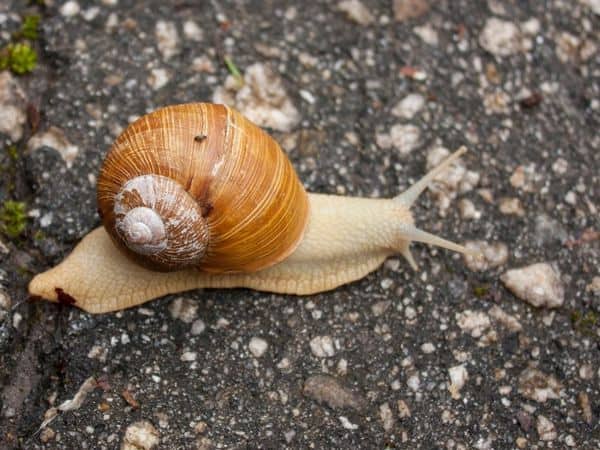Snail farming in Canada can be very successful when the local market is strong enough. Snails are a very nutritious delicacy, with high protein value. Snail farming is more popular in South America, West Africa (Nigeria), and some parts of Asia (Vietnam).
Canada is located in North America and does not practice snail farming on a large scale like it is practiced in the Northern states. Therefore, commercial snail farming in Canada may prove a challenge due to the many government policies involved.

Before reading further, Here are other articles on – snail farming in the USA  and snail farming in Asia
and snail farming in Asia . Feel free to check them out later.
. Feel free to check them out later.
Is Snail Farming legal in Canada?
Snail farming is legal but regulated by the Canadian Food Inspection Agency. The CFIA (Canadian Food Inspection Agency) regulates the handling and import of live terrestrial snails in Canada under the Plant Protection Act (source ). This is because they can be destructive to the environment and harm the economy.
). This is because they can be destructive to the environment and harm the economy.
Snails may destroy vegetation including fruits, crops, vegetables, and also affect operations such as gardens, nurseries, parks, and greenhouses. They also reproduce very fast, making control a nightmare.
Since the impact of destruction on the environment vary depending on species, the CFIA regulations are drafted with respect to the species of snail. Some snails may be imported only for special purposes and be contained, (for instance exhibition or research). Others may be imported for personal or commercial purposes, (for instance snail farming or keeping them as pests)
The Canadian government under the CFIA regulates some terrestrial snails in Canada as quarantine pests, listed on the List of Pests Regulated by Canada (source ). The handling or import of these snails listed for personal or commercial use is prohibited.
). The handling or import of these snails listed for personal or commercial use is prohibited.
The handling or import of snails for personal or commercial use may be allowed for snails that are not listed as a pest by CFIA, provided that the snails:
- Belong to aquatic snails species that do not need an import permit under the Canadian Plant Protection Act.
- Belong to either O.vermiculata, Otala lacteal, or Capea nemoralis and are imported under the Canadian Plant Protection Act.
- Are collected from Canadian natural environment and are not recorded in Canada for the first time.
You must apply through the CFIA for permission to handle or import all snails in Canada. The Plant Protection Act is not the only requirement that may be needed when handling or importing snails in Canada; other requirements may also apply, depending on what the snail is intended to be used for.
For instance, if you are importing snails food, the CFIA’s Safe Food for the Canadians Regulation may also be required.
Are there edible snails in Canada?
The common terrestrial snail in Canada known as genus Helix is edible. This snail delicacy is prepared with seasoned garlic butter. Other edible snails available in Canada include the conch and the abalone. (Source )
)
The France delicacy popularly known as escargot is basically cooked snail, very popular in various parts within Europe, including Canada. Note that not all land snail species are edible. The most common edible land snail species include Cornu aspersa, Elona quimperiana, Iberus aloneness, Helix pomatia, and Helix lucorum.

While some marine snails have been proved to be toxic creatures in this world, terrestrial snails are safe for consumption.
Cultivation and consumption of snails across the globe are popular to variable degrees in the US, Indonesia, Spain, China, France, as well as African countries (largely in Cote d’ Ivoire, Ghana, Nigeria, and Algeria.
There are many health benefits of snail delicacy. Snails are high-protein creatures and low in fat. It also promotes the production of red blood cells in the body that benefit muscles and other body tissues. Snail delicacy can also provide half of the daily recommended selenium intake that helps in preventing heart disease, thyroid.
They are also a source of minerals such as potassium, iron, phosphorus, and magnesium which are very crucial for human health.
Read more about the health benefits of snails here .
.
How much is a snail in Canada?
Snail prices in Canada can be analyzed in terms of Canada export prices, Canada export market value, and Canada wholesale price. (Source )
)
Export prices for Canadian snails
Snail prices in Canada have increased. 1 Kg of snails was going for $7.09 in the year 2017 and $7.67 in the year 2018. The export price has changed by 10.22 percent to $8.46 per Kg in the year 2019.
Export market values for Canadian snails
The total export market value for snails in Canada were $1,152, $2,992, $1730, and $2, 316 for the years 2019, 2018, 2017, and 2016 respectively.
Canada snails wholesale price
The approximate wholesale price range for snails in Canada is between $3.84 and $3.48 per pound or $8.47 and $7.67 per kilogram in 2021. The wholesale price is 10.57 per Kg, Canadian Dollar. The average price is $8470.59 per tonne in Ottawa and Montreal.
Where are snails found in Canada?
Terrestrial species in Canada are mostly found in leaves or under rocks and logs since they require moisture. Most species are hermaphrodites, with both female and male sexual organs for cross-fertilization.
Some species such as the endangered Physella johnsoni (Banff Springs snail) have specific habitats. Their world population is restricted to Banff National Park. Most of the snail habitat threats include habitat degradation or destruction, climate change, aquatic pollution (for freshwater species), and invasive species.

Do freshwater snails live in Canada?
There exist about 326 known species of freshwater snails and slugs, and terrestrial in Canada. Most of these species are secure. Freshwater snails are found in almost all types of aquatic habitats in Canada, from the Everglades of Florida to the Canadian Arctic. (Source )
)
They are mostly found in the Great Lakes region. Regions with extreme temperatures and northern latitudes have very few species of freshwater snails.
Freshwater snails come in a vast range of sizes, colors, and shapes. Some species such as hydrobiids are only a few millimeters in height, while viviparids can be greater than 40 millimeters. Planorbids adopt the shape of a ram’s horn, while limpets are flat, resembling a capital building’s dome.
Freshwater snails have bodies that can be drab yellow-brown with a red hue and striking blue.
Wrap up
Although snail farming isn’t practiced on a large scale in Canada, it is possible, but you have to first seek permission from the Canadian Food Inspection Agency. Provided the type of snail you wish to breed isn’t part of those listed in the List of Pests Regulated by Canada, you are free to begin your snail farm.

